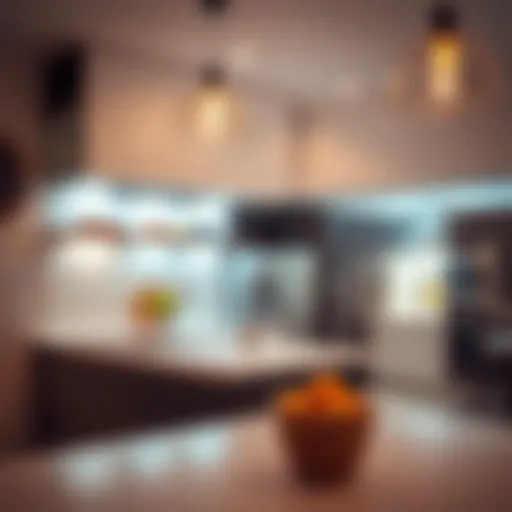The Beauty and Charm of Orange Glass Lamps in Design
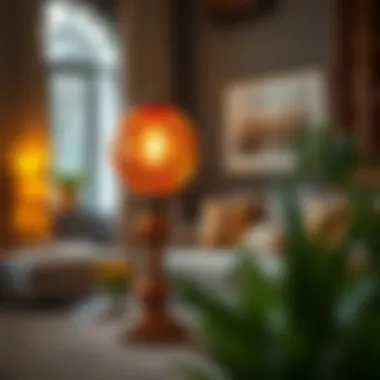
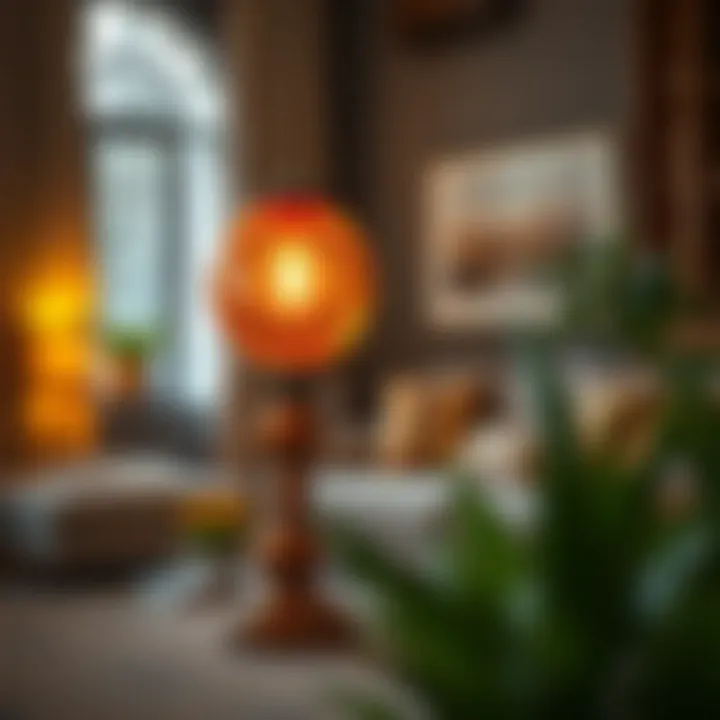
Intro
When it comes to lighting, most people don't realize the profound impact it has on a home's atmosphere. Orange glass lamps, with their warm and vibrant hues, play a unique role in creating that ambiance. Their charm is not just in the color but also in their ability to blend seamlessly into various interior styles, from contemporary to vintage. This article aims to unravel the complexity behind orange glass lamps, diving into their history, the trends they embody, and the psychological effects of their color. Moreover, we'll take a look at some tips for making these lamps a focal point in your home, offering real value to homeowners, interior designers, and DIY enthusiasts alike.
Design Trends
Contemporary Styles
In recent years, contemporary design has embraced bold colors and innovative shapes. Orange glass lamps fit wonderfully into this narrative, adding vibrancy to modern interiors. Designers often opt for sleek, minimalist bases that let the vivid glass take center stage. The combination of clean lines and vibrant colors allows these lamps to complement a variety of settings, whether it’s a chic urban loft or a cozy suburban home. The trend of mixing textures also plays a role. You might find orange glass paired with rustic wood, metal accents, or even fabric soft furnishings, creating a rich tapestry of design.
Vintage Inspirations
On the flip side, vintage styles have made a remarkable comeback. Many homeowners are keen on integrating retro or antique styles into their spaces. Orange glass lamps hark back to the mid-century modern era, showcasing unique designs that evoke nostalgia. Think about how the soft glow of a textured orange glass lamp can transport you back to simpler times. Antique shops and flea markets offer a treasure trove of vintage pieces that can add character to modern spaces, making them conversation starters and focal points.
Material Innovations
Sustainable Materials
As the conversation around sustainability gains momentum, the production of orange glass lamps has seen a shift towards eco-friendly materials. Artisans are increasingly using recycled glass in their creations, which not only reduces waste but also provides a unique aesthetic. The imperfections in recycled glass often tell a story, adding charm that synthetic materials cannot replicate. This trend speaks volumes about consumer preferences—people want not just a beautiful lamp, but one that aligns with their environmental values.
Smart Furniture Technology
Moreover, the integration of smart technology into everyday items is changing the landscape of home decor. Some modern orange glass lamps come equipped with smart features like adjustable brightness, color temperature, and even connectivity to smart home systems. This enables homeowners to customize their lighting experience effortlessly. Imagine controlling the mood of your space with a simple voice command or app. The marriage of striking design and modern technology makes these lamps not just attractive but functional as well.
"Lighting is where technology meets design in the most intimate way."
The End
The allure of orange glass lamps extends beyond mere illumination; it delves into the realms of emotional engagement and design aesthetics. With design trends leaning towards both contemporary and vintage styles, coupled with advancements in materials and technology, there’s no shortage of creative possibilities. As you look to brighten your spaces, consider how an orange glass lamp might just be the statement piece you never knew you needed.
Preamble to Orange Glass Lamps
In recent years, home decor has taken a turn towards personal expression, and lighting plays a crucial role in setting the right atmosphere. Among various lighting options, orange glass lamps have gained notable attention. Why? Because they’re not just about illuminating spaces; they create moods, enhance aesthetics, and bring uniqueness to any room. This article aims to disentangle the allure of these lamps, weaving insights into their history, design trends, and practical applications to help homeowners and decorators alike to harness their potential.
Defining Orange Glass Lamps
Orange glass lamps are, quite literally, lamps made of orange-colored glass. But that’s not the sum of their charm. The color orange, striking yet warm, often evokes feelings of comfort and creativity. Anyone who has strolled through a thrift store might have encountered an array of orange glass lamps—from sleek, modern designs to those with a vintage flair.
These lamps serve a dual purpose: not just as light sources, but also as conversation starters that reflect the personality of a space. For instance, a minimalist flat may benefit from an artistic orange lamp that infuses character without overwhelming the room. Moreover, they can fit into a variety of styles, be it eclectic, retro, or contemporary. They say, "the devil is in the details", and indeed, orange glass lamps can be the detail that ties a room together.
The Aesthetic Appeal of Orange Glass
Color has a profound influence on our emotional states and perceptions. Orange glass lamps can shift the atmosphere dramatically, lending an inviting feel to spaces.
- Creating Warmth: The right shade of orange can warm up a cold room, making it feel cozy and welcoming. This is particularly true in living areas or bedrooms where relaxation is key.
- Enhancing Visibility: Beyond looks, these lamps aren't slouches when it comes to practicality. The light emitted, filtered through orange glass, tends to soften harsh edges. It's a gentle reminder that light doesn’t have to be glaring to be effective.
- Artistic Presence: Each lamp carries its own design ethos. The craftsmanship can vary vastly; some lamps may sport intricate patterns or textures that augment their beauty, making them worthy of being showcased.
"A well-placed orange lamp can be the visual anchor in any room, drawing the eye while harmonizing its surroundings."
In summary, orange glass lamps are far more than mere lighting fixtures; they encapsulate a blend of functionality and artistry, providing warmth and an aesthetic appeal that resonates with many design philosophies. Their allure lies not only in their vivid color but also in their ability to transform spaces and elevate everyday living.
Historical Significance
When it comes to orange glass lamps, understanding their historical significance provides a deeper appreciation for their beauty and utility. These pieces are not merely functional lighting but rather artifacts of human creativity, reflecting socio-cultural shifts in design and artistry through the ages. Knowing their backgrounds can enhance how they are perceived in contemporary interior design.
Origins of Glass Lamps
The origins of glass lamps can be traced back to ancient civilizations, where the fundamental need for light led to experimentation with various materials. The early versions of glass lamps were often primitive, using oil or tallow with rudimentary containers made from materials like clay or metal. It was not until the Roman Empire that more sophisticated glass-making techniques began to emerge. Roman artisans mastered the art of glass blowing around the 1st century AD, leading to a proliferation of glassware in homes and public spaces.
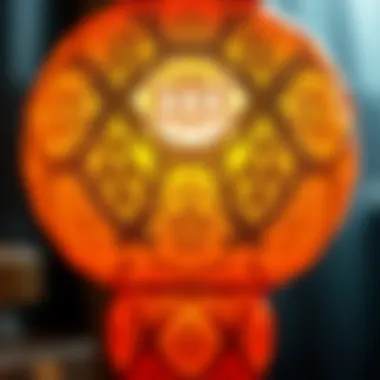
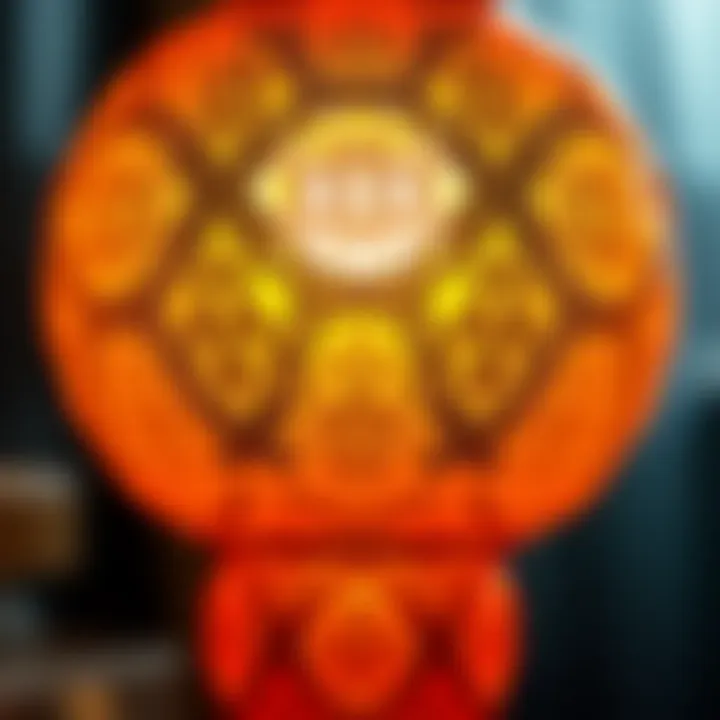
In many ways, Roman glass lamps can be seen as a bridge between function and art. They often featured intricate designs, oftentimes displaying colorful patterns reminiscent of the vibrant hues we see in modern glass lamps today. Over the centuries, the techniques of glass-making spread throughout Europe and later to other parts of the world, morphing into unique styles that would eventually encompass the alluring orange glass lamps we admire today.
The Evolution of Color in Glass Lighting
The evolution of color in glass lighting marks a fascinating journey through art, societal preferences, and technological advancements. In the early days, color was primarily achieved through additives in the glass-making process, often limited by available materials. The introduction of manganese in the late 19th century allowed for a wider palette of colors, including shades of orange.
As we moved into the 20th century, advancements in technology and changes in design philosophy turned vibrant colors from a desirable trait into a defining characteristic. This shift coincided with the Arts and Crafts movement, which prioritized handcrafted items, inspiring artisans to create colorful, unique pieces of art. Orange glass lamps gained popularity not just for their functional role but for their emotional capacity to evoke warmth and cheerfulness.
Today, orange glass lamps often signify a blend of tradition and modernity. Their hues are typically associated with a sense of vitality and energy in a space, making them a desirable choice among homeowners, interior designers, and decorators. Their historic roots provide context for current trends and preferences, subtly intertwining the past with contemporary design.
"Understanding the evolution of color in glass lighting is crucial for grasping its impact on modern home decor styles."
Exploring the historical significance of orange glass lamps helps to provide insightful context for their current appeal and functionality in home design. Recognizing where they come from enhances not just an appreciation of their aesthetic qualities but anchors them within a rich tapestry of human history.
Design Trends in Orange Glass Lamps
In the realm of interior design, orange glass lamps are carving a niche that speaks both to contemporary styles and nostalgic aesthetics. These lighting pieces do more than just illuminate a space; they weave together the threads of color and light, impacting not only the visual aspect of a room but also its mood and vibe. Today's design trends reflect a growing appreciation for unique materials and bold colors, such as orange, which can transform an ordinary environment into an extraordinary one.
The current trend revolves around the use of orange glass as a pivotal element in modern interiors. The sheer versatility of the hue—from soft peach to vibrant tangerine—makes it suitable for a plethora of styles. Homeowners and professionals alike are drawn to these designs because they evoke warmth and creativity. Using orange glass lamps strategically can create focal points that invite conversation and admiration, making them a practical yet stylish choice for any room.
Contemporary Designs
Contemporary designs of orange glass lamps are vast and varied, capturing an elegant yet playful spirit. One of the standout characteristics of these modern lamps is the geometric shapes and clean lines that are prevalent in today’s decor. For instance, lamps with sleek, cylindrical bodies or angular bases stand out as both functional and eye-catching. These designs often incorporate innovative lighting technologies, such as LED options, which enhance their usability and energy efficiency.
A well-known trend is the use of multiple shades integrated into a single lamp. Imagine an orange glass lamp that features overlapping conical shapes, interplaying shades of tangerine and burnt orange. This not only creates depth but also casts beautiful, warm light throughout a room. Such innovative takes on traditional lamp designs reflect a shift toward personalized decor—an embodiment of individual style that homeowners seek.
Additionally, the choice of materials continues to evolve, with many contemporary designs embracing a combination of glass and metals such as brass or gold accents. This blend enhances the visual appeal and adds a touch of sophistication. The fusion of different materials in a single piece captures attention and provides a tactile experience, making a simple lamp a centerpiece in modern decor.
Vintage and Retro Influences
Take a step back in time, and you’ll find that the vintage and retro influences on orange glass lamps breathe life into contemporary settings. The charm of mid-century modern design, with its bold colors and organic forms, significantly influences current lamps. Vintage orange glass lamps often feature whimsical elements—think of curved silhouettes, small decorative knobs, and intricate patterns that evoke a sense of nostalgia.
A popular theme includes lamps that imitate the mottled effect of older glass, where shades of orange subtly blend with other colors, creating a mesmerizing visual experience. Homeowners often seek these vintage pieces to add character and history to their spaces, fusing nostalgia with modern sensibilities. This embrace of the past also reflects a growing trend toward sustainability, as consumers are increasingly interested in unique, timeless designs rather than mass-produced items.
Furthermore, vintage-inspired lamps paired with contemporary furniture can create a striking juxtaposition that adds depth and interest to interiors. For example, placing an ornate, retro orange glass lamp on a minimalist white desk carves out a dialogue between eras, merging the charm of yesteryears with the sleek sophistication of today’s styles.
Color Psychology and Its Implications
Understanding color psychology is crucial for anyone delving into interior design, especially when considering unique elements like orange glass lamps. The colors we choose to surround ourselves with can deeply influence our emotions, behaviors, and overall atmosphere in a space. By exploring the implications of color psychology, homeowners and designers can make more informed choices that align with their desires for comfort and aesthetic.
Effects of Orange in Home Decor
The color orange is often seen as vibrant and warm, stirring feelings of enthusiasm and energy. When it comes to interior decor, orange can serve as both a dominant feature or a subtle accent. Its effects can vary dramatically depending on the shade and placement of orange glass lamps.
- Energizing Ambiance: Orange tends to evoke a sense of warmth, making spaces feel inviting. It's perfect for areas where gatherings happen, such as living rooms or dining areas. When illuminated by orange glass lamps, these areas become alive with a soft glow that encourages conversation and connection.
- Creative Stimulation: Many people associate orange with creativity. Thus, incorporating orange glass lamps into a workspace can foster a lively atmosphere conducive to innovative thought. This could be particularly useful in home offices or creative studios where inspiration is key.
- Warmth and Comfort: The hue can also create a sanctuary-like feel in spaces where relaxation is central, like bedrooms. A soft, subtle orange from a lamp can create a cocoon of comfort, especially during the colder months.
Associations with Emotion and Mood
Orange’s rich character appeals to a range of sentiments, making it a versatile choice in design. Understanding these associations is vital, especially when selecting orange glass lamps for different environments.
- Social Connectivity: Orange creates a sense of warmth that encourages social interaction. It’s beneficial for homes where family and friends gather. Here, orange glass lamps can accentuate the inviting atmosphere, subtly enhancing the mood.
- Cheerfulness and Positivity: Many find that the orange hue can uplift spirits. This can be particularly useful in spaces like playrooms or children’s areas, where a sense of joy and fun is essential.
- Caution for Overuse: While orange can inspire positivity, overdoing it might lead to feelings of agitation. Moderation is key. A well-placed orange glass lamp can add vibrance without overwhelming the senses, making it essential to balance orange decor with calmer tones.
"When designing, remember that the mood can shift with one simple change in color, particularly with shades as lively as orange."
Manufacturing Techniques
When discussing orange glass lamps, the methods used in their manufacturing play a crucial role in defining their aesthetic and functional qualities. These techniques dictate not just how a lamp looks, but also how it performs, ensuring durability and an effective delivery of light. Understanding the different manufacturing methods allows homeowners, interior designers, decorators, and DIY enthusiasts to appreciate the craftsmanship and choose lamps that best fit their needs.


Blown Glass Techniques
Blown glass is a time-honored technique in the lamp-making industry that brings unique character to each piece. The process begins with a gather of molten glass, which the artisan blows into a bubble while shaping it into a desired form. This method allows for a range of shapes and sizes, creating stunning visual effects, especially with orange hues, as the light passes through.
- Craftsmanship: Each lamp is a piece of art. As the artisan manipulates the glass, subtle variations in thickness and surface texture occur, often producing one-of-a-kind pieces that are hard to replicate.
- Color Infusion: The deep, rich colors of orange can be enhanced during blow molding by adding metal oxides or other colorants. This integration creates vibrant shades, which can vary from a soft amber to a striking tangerine, making each lamp unique in its hue.
- Variability: Blown glass lamps may have small imperfections that add to their charm. This tactile quality is often appreciated by discerning consumers who value authenticity over mass production.
"Each blown glass piece tells its own story. It's not just about the light it casts, but the artistry behind its creation."
Stained vs. Paint Techniques
When it comes to color application on glass, two prominent methods are stained glass and painted glass. Both techniques can result in captivating orange lamps but differ significantly in their processes and outcomes.
Stained Glass Techniques
Stained glass lamps involve the use of colored glass pieces. This method is deeply connected with traditional craftsmanship.
- Selection of Glass: The colored glass is selected for its inherent hues, ensuring that each piece adds to the final visual effect.
- Joining with Lead: The pieces are then joined using lead came or foil, forming intricate patterns that allow light to be filtered through beautifully.
- Durability: Stained glass lamps are often more resilient to changes in temperature and humidity, making them suitable for various environments.
Paint Techniques
In contrast, painted glass lamps are adorned with color after the glass has been formed. This technique generally involves applying paint and then firing the piece in a kiln to set the color firmly.
- Flexibility in Design: This method allows for more intricate designs or detailed artwork that may not be possible with stained glass.
- Color Comparison: Painted lamps tend to offer a broader range of colors and finishes, lacking the depth of color found in stained glass, while still providing vibrant options.
- Care and Maintenance: Ironically, painted surfaces may require a little more care, as surface scratches can diminish their visual appeal over time.
Understanding these manufacturing techniques is essential for anyone looking to invest in orange glass lamps, as they ultimately guide the selection process and ensure each piece enhances the overall aesthetic of a space.
Placement and Integration in Interior Spaces
The placement and integration of orange glass lamps within interior spaces holds immense significance in the realm of interior design. These lamps, with their vibrant hues and unique craftsmanship, can effortlessly transform any room, making it feel warm and inviting. Understanding how to effectively incorporate these pieces is key to unlocking their potential.
Highlighting Spaces with Orange Glass
Orange glass lamps serve as striking focal points that can highlight various areas in a home. The warm glow emitted by these lamps creates an ambience that many homeowners and decorators yearn to achieve. Here are some spaces where orange glass lamps can elevate the overall design:
- Living Rooms: A well-placed orange lamp can define seating areas, offering both light and style. For instance, placing a lamp on a side table next to a sofa makes for a cozy reading nook.
- Bedroom: Orange glass lamps can add a touch of serenity when used as bedside lighting. Their soft illumination is perfect for winding down at the end of the day.
- Kitchens: Integrating orange lamps in kitchens can enhance the lively atmosphere. Consider hanging pendant lamps above an island to create a welcoming space for family and friends.
"A touch of orange goes a long way, bringing a sense of life and creativity to any space."
Practical Tips for Placement
When it comes to the practical aspects of placing orange glass lamps, several considerations come into play. Here are key tips to ensure that the lamps complement the room’s design:
- Scale Matters: Select lamps that are proportionate to the furniture around them. A large lamp works well beside a substantial sofa but might overwhelm a petite side table.
- Layer Lighting: Use orange glass lamps as a part of a layered lighting strategy. Combining task, ambient, and accent lighting can create depth and mood in a room.
- Consider Color Coordination: Pair orange lamps with complementary colors in the room. Soft blues or earthy tones can create a pleasing contrast, letting the orange pop.
- Functional Placement: Ensure that lamps not only look good but also provide adequate lighting for their intended use. For reading, a lamp should be placed at the right height to cast light where it’s needed.
- Placement Height: The height at which you place lamps can change the mood. Higher lamps generally create a broader spread of light, while lower placement can offer coziness.
Incorporating these strategies when using orange glass lamps can lead to a harmonious and aesthetically pleasing environment. With just the right placements, these lamps become more than just light sources—they transform into art pieces that enhance the overall feel of a home.
Practical Considerations for Consumers
In the world of interior design, the choice of lighting can make all the difference. This is especially true for orange glass lamps, which not only serve a practical function but also contribute significantly to the ambiance of a space. Consumers seeking these lamps must navigate several factors to ensure that their selection enhances their environment while also meeting their needs.
Choosing the Right Lamp for Your Space
The initial step in choosing the right orange glass lamp involves assessing the space where it will be used. Size matters; a lamp that is too small can get lost in the room, while one that is too big can overwhelm the existing decor. Measure the area and consider factors such as the height of tables or surfaces where the lamp will reside. The lamp should complement the scale of the room and the furnishings rather than overpowering them.
Next, think about the intended use of the lamp. Is it for reading, ambient light, or as a decorative piece? Orange glass lamps come in various styles, from elaborate designs with intricate patterns to minimalistic options that focus solely on color. Understanding the purpose will guide you towards making a more informed decision. For example, a task light should provide bright illumination, whereas an accent lamp can serve a more decorative role while subtly lighting the surroundings.
Consider these aspects when selecting your lamp:
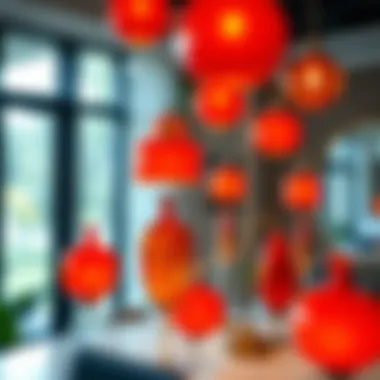
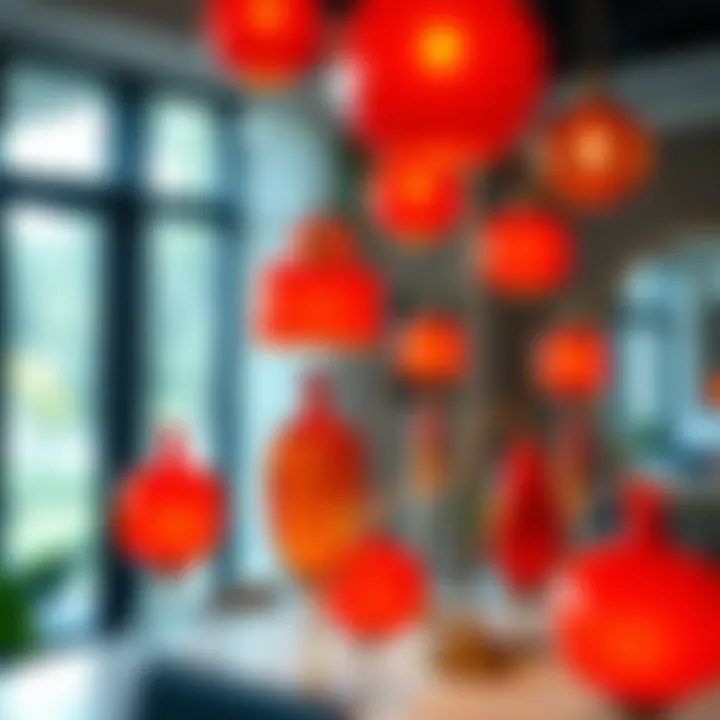
- Style: Match it with your existing decor.
- Size: Ensure it fits proportionately with furniture.
- Functionality: Decide if it’s for reading, decor, or ambiance.
Maintenance and Care of Glass Lamps
Once you’ve chosen the perfect orange glass lamp, maintaining it is crucial to ensure longevity and visual appeal. Glass can be fragile, thus necessitating careful handling. Regular dusting is essential; a microfiber cloth is ideal for instilling that crystal-clear shine without scratching the surface. While it may be tempting to just pick up any cleaning agent, it’s important to avoid harsh chemicals. Instead, opt for warm, soapy water or a specially formulated glass cleaner that won't damage the finish or color.
Furthermore, be vigilant about its placement. Avoid areas prone to heavy traffic or spots where accidental bumps might occur. If you have children or pets, consider securing the lamp to prevent fall damage.
Helpful maintenance tips include:
- Use microfiber cloths for dusting.
- Avoid harsh cleaners; stick to warm soapy water.
- Position your lamp in safe, less trafficked areas.
The allure of orange glass lamps lies not just in their aesthetics but also in how they can be adapted to fit within personal design philosophies. Through practical considerations, from selection to maintenance, homeowners and decorators alike can ensure these lamps remain stunning centerpieces within their spaces.
Case Studies in Design
The case studies featured in this article shine a spotlight on the practical and aesthetic applications of orange glass lamps across different environments. These examples illustrate how homeowners and designers creatively integrate these unique lighting fixtures, enhancing both function and flair within their spaces. By examining real-world instances, we can grasp the importance of context and design intent when utilizing orange glass lamps. This promotes a deeper understanding of choices made by creators—revealing not just the lamp as a standalone object, but as an integrated part of a larger design narrative.
Residential Applications
In residential settings, the integration of orange glass lamps can transform a space from ordinary to extraordinary. Imagine stepping into a cozy living room where a beautifully crafted orange glass lamp takes center stage atop a rustic side table. The soft glow casts warm shadows, inviting relaxation. Key elements to consider in such applications include:
- Color Balance: In a setting dominated by muted shades, an orange glass lamp provides a pop of vibrancy. The warm hue complements neutrals elegantly, making it a perfect focal piece.
- Functional Design: Many of these lamps serve dual purposes—functioning as both art and lighting. They can easily be used as reading lamps, or ambient lights, depending on the position and wattage of the bulb.
- Material Interaction: Introducing a glass element can soften the harsh edges often found in modern decor. Orange glass pairs beautifully with wood and metal, adding depth and character to furniture.
A particular case worth noting is a craftsman-style interior where a hand-blown orange glass lamp hung over a dining table. This lamp not only illuminated the area, but its design echoed the organic shapes of the surrounding architecture, exemplifying how lighting can extend the room’s ethos.
Commercial Spaces and Their Use of Orange Glass
Commercial settings also greatly benefit from the strategic use of orange glass lamps. More than just illumination, these fixtures act as brand statements. Companies are increasingly aware of how color and light influence customer experiences.
In retail, for example, an orange glass lamp may line the ceiling of a boutique, casting a trendy glow that enhances product displays while fostering a relaxed shopping ambiance. Considerations for commercial spaces include:
- Brand Identity: The color of orange evokes feelings of warmth and approachability. Businesses are using these lamps to create environments that feel welcoming—encouraging customer interaction and loyalty.
- Versatile Placement: Unlike wall-mounted fixtures, orange glass lamps can be moved and adjusted to suit various layouts—a crucial factor in spaces that host different events or displays.
- Innovative Design: Unique lamp designs can serve as conversation starters, adding flair to cafes or galleries, where patrons linger longer under thoughtfully crafted light.
A coffee shop featuring a series of hanging orange glass lamps illustrates this principle effectively, with each piece acting as a conversation starter while subtly reinforcing the brand's aesthetic. Other examples include artisanal shops, where the lamps highlight handmade goods, emphasizing craftsmanship and thoughtfulness that resonates with customers.
The thoughtful integration of orange glass lamps in both residential and commercial venues shows how light can sculpt moods and enhance experiences, underscoring the transformative power of design in everyday interactions.
Case studies in the application of orange glass lamps reveal a vivid intersection of functionality and artistry, encouraging innovative thinking among designers and homeowners alike. As we witness these trends unfold, it's clear that the allure of orange glass is more than a fleeting fashion—it's becoming a staple in both personal spaces and commercial realms.
Closure and Future Trends
As we look ahead to the world of interior design, the role of orange glass lamps is poised to evolve further, showcasing their ability to blend tradition with innovation. The conclusion of this exploration serves as a reminder of the significance these lamps hold—not just as functional lighting fixtures, but as enduring statements of style and comfort within our living spaces.
Orange glass lamps epitomize warmth and vibrancy, capturing the essence of inviting environments. They are more than mere illuminators; they serve as focal points, enriching the aesthetic of rooms while providing an emotional uplift associated with the vibrant hue. The future of these lamps is bright, quite literally, as designers and manufacturers push the boundaries of creativity in both materials and technology.
Anticipated Innovations in Glass Lamp Designs
Looking ahead, several trends and innovations are expected to shape the future of orange glass lamps:
- Sustainable Materials: With the growing emphasis on eco-friendly products, we might see a shift towards sustainable glass options, using recycled materials or innovative production methods that reduce waste.
- Smart Lighting Technology: Integration of smart technology allows for greater control over light settings. Imagine being able to adjust the warmth of your orange hues to match your mood or the time of day with just a tap on your smartphone.
- Customizable Designs: Personalization is becoming key in home decor, and we can anticipate companies offering customizable orange glass lamp designs. Homeowners will be able to select not only the shape but the specific tint or pattern, making each piece unique to their space.
- Mixed Media Creations: The integration of other materials like metal or wood with orange glass will likely see an uptick. This combination can create striking contrasts that enhance the visual appeal and versatility of lamp designs.
These anticipated innovations are just the tip of the iceberg, and as new technologies develop, the potential for unique designs is practically limitless.
The Enduring Allure of Orange Glass Lamps
The charm of orange glass lamps is far from transient; instead, it is deeply rooted in their ability to transform the atmosphere of any space. Their allure lies not only in their aesthetic charm but also in their versatility. From cozy living rooms to sleek office spaces, these lamps enhance environments in ways that resonate emotionally with the occupants.
They symbolize optimism and creativity while providing much-needed warmth in colder designs. When one considers the various shades that orange can offer—from soft peach to bold tangerine—the possibilities for incorporation into design schemes become extensive.
Moreover, their historical relevance—a journey from artisanal craftsmanship to modern manufacturing—adds a layer of depth. This timeless quality ensures that orange glass lamps will always maintain a place in contemporary design. They invite guests in, create inviting spaces, and punctuate the individuality of each home or office environment.
In summary, as we embrace future trends and innovations, the magnetic appeal of orange glass lamps will continue to thrive, evoking nostalgia while simultaneously paving the path for new creative possibilities.

